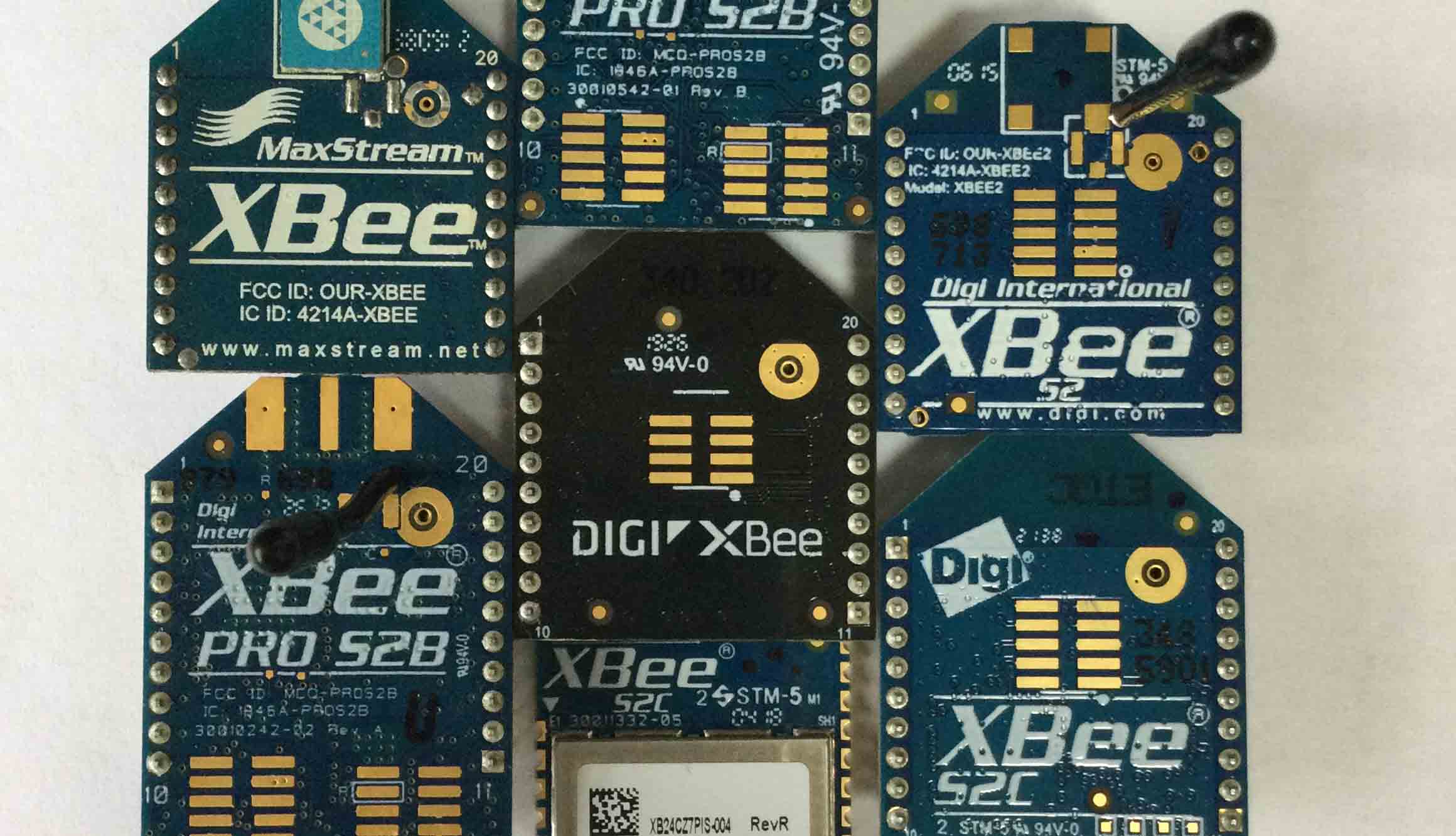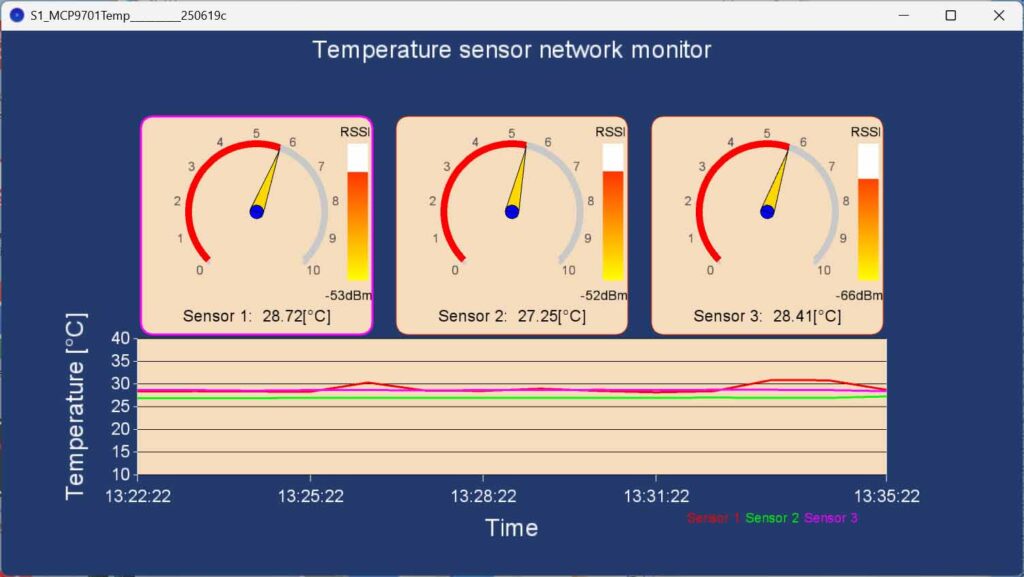
前回はファームウェアを802.15.4に設定しアナログ温度センサMCP9701(Microchip社製)を3個のエンドデバイスXBeeに接続し、Cyclic Sleep Modeを用いて60秒間隔でコーディネータXBeeに温度結果を送信しました。今回はコーディネータXBeeで受信した3個のエンドデバイスXBee からの温度データやRSSIを読み取り、Processing を用いてリアルタイムでデータを表示するスクロールグラフをご紹介します。
Processingについては5月24日の「XBeeモジュールの使い方(アナログ温度センサの温度データ可視化)」の記事を参考にしてください。今回はこのときの記事で記載した設定条件でスクロールグラフを作成しました。
以下のコードで3個のエンドデバイスの温度データをスクロールグラフで表示します。以下のコードをProcessingで実行する前に、ローカルXBeeとのシリアル通信のCOMポート番号とボーレートを48行目に入力してください。
xbee = new Serial(this, “COM14”, 9600);
また28行目では温度データをcsvファイルに保管するインターバルを設定することができます。デフォルトでは1時間に設定しています。
int interval = 3600000; // 1時間 ミリ秒で指定 10分=600,000ミリ秒
import processing.serial.*;
import java.io.PrintWriter;
import java.text.SimpleDateFormat;
import java.util.Date;
import java.util.ArrayList;
Serial xbee; // input serial port from the Xbee Radio
int[] packet = new int[14]; // with 5 samples, the Xbee packet is 24bytes long
int byteCounter; // keeps track of where you are in the packet
int fontSize = 24; // size of the text on the screen
int dc = 0; // データ数
int Addr = 0;
int addrRead = 0;
int RSSI = 0;
byte thisSample1;
float minTemp = 10;
float maxTemp = 40;
float tempkizami = 0;
String address; // sender's address
float Signal = 0; // average of the sensor data
float Signalv = 0;
int firstRectPos = 25; // horizontal pos of the first graph bar
int AddrNum = 3; // アドレスの数
ArrayList<Float>[] signals = new ArrayList[AddrNum]; // 各アドレスごとの温度データを保存するリスト
ArrayList<Float>[] timeSeriesData = new ArrayList[AddrNum]; // 各アドレスごとの時系列データを保存するリスト
ArrayList<String>[] timeLabels = new ArrayList[AddrNum]; // 各アドレスごとの時間ラベルを保存するリスト
int interval = 3600000; // 1時間 ミリ秒で指定 10分=600,000ミリ秒
int lastSaveTime = 0; // 最後にデータを保存した時間
float[] temperatures = new float[AddrNum];
float[] rssiValues = new float[AddrNum];
PFont font;
void setup() {
size(1500, 800, P3D); // ウィンドウサイズを大きくしてNumSensor個のメータを表示
surface.setResizable(true);
frameRate(1); // 1秒間隔で更新
font = createFont("MS P明朝", 20);
textFont(font);
// create a font with the second font available to the system:
PFont myFont = createFont(PFont.list()[5], fontSize);
textFont(myFont);
// get a list of the serial ports:
println(Serial.list());
// open the serial port attached to your Xbee radio:
xbee = new Serial(this, "COM14", 9600);
// 初期化
for (int i = 0; i < AddrNum; i++) {
signals[i] = new ArrayList<Float>();
timeSeriesData[i] = new ArrayList<Float>();
timeLabels[i] = new ArrayList<String>();
}
lastSaveTime = millis();
}
void draw() {
background(35, 59, 108);
// set the background:
fill(255, 255, 0);
// 各メータの位置とサイズ
float meterSize = 200;
float[] meterX = new float[10];
for (int i = 0; i < AddrNum; i++) {
meterX[i] = (1 + i) * width / (AddrNum + 1);
}
float meterY = height / 3;
for (int i = 0; i < AddrNum; i++) {
fill(245, 220, 189);
rect(meterX[i] - 170, meterY - 140, 340, 320, 20);
drawMeter(meterX[i], meterY, meterSize, temperatures[i], rssiValues[i], i + 1);
}
// 時系列データのグラフ描画
drawTimeSeriesGraph();
// 指定の時間が経過したらデータを保存
if (millis() - lastSaveTime > interval) {
saveData();
lastSaveTime = millis();
}
}
void drawBar(int rectHeight, int rectWidth, int rectNum ) {
if (rectHeight > 0 ) {
stroke(255, 127, 0);
fill(123, 255, 0);
}
}
void serialEvent(Serial xbee) {
int thisByte = xbee.read();
if (thisByte == 0x7E) { // start byte
if (packet[5] > 0) {
parseAddr(packet);
}
if (packet[6] > 0) {
parseRSSI(packet);
}
// parse the previous packet if there's data:
if (packet[11] > 0) {
parseData(packet);
}
// reset the byte counter:
byteCounter = 0;
}
// put the current byte into the packet at the current position:
packet[byteCounter] = thisByte;
// increment the byte counter:
byteCounter++;
}
void parseRSSI(int[] thisPacket) {
int RSSI_StartByte = 6;
RSSI = -thisPacket[RSSI_StartByte];
rssiValues[Addr - 1] = RSSI;
println("RSSI:" + RSSI);
}
void parseAddr(int[] thisPacket) {
int addrRead = 5;
Addr = thisPacket[addrRead];
println("Addr:" + Addr);
}
void parseData(int[] thisPacket) {
int adcStart = 11; // ADC reading starts at
// ADC 10-bit value = high byte * 256 + low byte:
int thisSample = (thisPacket[adcStart] * 256) + thisPacket[1 + adcStart];
println(thisPacket[adcStart]);
println(thisPacket[1 + adcStart]);
//Signalv = float(thisSample) / 310; // for LM90
Signalv = float(thisSample) / 838.5; // for MCP8701
println(Signalv);
//Signal = sqrt(2196200+(1.8639-Signalv)/(3.88E-6)) - 1481.96; // for LM90
Signal = (Signalv*1000 - 400) / 19.5; // for MCP9701
println("Signal:" + Signal);
// アドレスに応じてデータを保存
if (Addr >= 1 && Addr <= AddrNum) {
signals[Addr - 1].add(Signal);
temperatures[Addr - 1] = Signal;
timeSeriesData[Addr - 1].add(Signal); // 時系列データに追加
timeLabels[Addr - 1].add(new SimpleDateFormat("HH:mm:ss").format(new Date())); // 時間ラベルを追加
}
}
void saveData() {
String timestamp = new SimpleDateFormat("yyyyMMdd_HHmmss").format(new Date());
String fileName = "C:/Users/kurita/Desktop/TempData/TempData_" + timestamp + ".csv";
PrintWriter output = createWriter(fileName);
// ヘッダー行の作成
String header = "Time";
for (int i = 0; i < AddrNum; i++) {
header += ",Addr " + (i + 1);
}
output.println(header);
// データ行の作成
int maxRows = 0;
for (int i = 0; i < AddrNum; i++) {
maxRows = max(maxRows, signals[i].size());
}
for (int row = 0; row < maxRows; row++) {
String line = "";
for (int col = 0; col < AddrNum; col++) {
if (col > 0) line += ",";
if (row < timeLabels[col].size()) {
line += timeLabels[col].get(row) + ",";
} else {
line += ",";
}
if (row < signals[col].size()) {
line += signals[col].get(row);
}
}
output.println(line);
}
output.flush();
output.close();
println("Data saved to " + fileName);
// データのリセット
for (int i = 0; i < AddrNum; i++) {
signals[i].clear();
timeSeriesData[i].clear();
timeLabels[i].clear();
}
}
void drawMeter(float meterX, float meterY, float meterSize, float temperature, float rssi, int sensorID) {
pushStyle();
// 温度スケール
float minTemp = 0;
float maxTemp = 50;
// 温度を表示する角度の計算 (左に90度回転)
float startAngle = radians(-225);
float endAngle = radians(45);
float angle = map(temperature, minTemp, maxTemp, startAngle, endAngle);
// メータのバックグラウンド
stroke(200);
strokeWeight(10);
//fill(200, 200, 200);
noFill();
arc(meterX, meterY, meterSize, meterSize, startAngle, endAngle);
// メータの目盛り
int tickCount = 10;
for (int i = 0; i <= tickCount; i++) {
float tickAngle = map(i, 0, tickCount, startAngle, endAngle);
float x1 = meterX + cos(tickAngle) * meterSize / 2;
float y1 = meterY + sin(tickAngle) * meterSize / 2;
float x2 = meterX + cos(tickAngle) * meterSize / 1.9;
float y2 = meterY + sin(tickAngle) * meterSize / 1.9;
line(x1, y1, x2, y2);
// メモリ値の表示
fill(70);
textSize(19);
textAlign(CENTER, CENTER);
float labelX = meterX + cos(tickAngle) * meterSize / 1.7;
float labelY = meterY + sin(tickAngle) * meterSize / 1.7;
text(int(i), labelX, labelY);
}
// 温度を表示する部分
stroke(255, 0, 0); // 赤色
strokeWeight(10);
fill(245, 220, 189);
arc(meterX, meterY, meterSize, meterSize, startAngle, angle);
// 指示針の描画(黒色の三角矢印)
fill(255, 215, 0);
stroke(0);
strokeWeight(1);
float needleLength = meterSize / 2.0;
float arrowSize = 10;
float x1 = meterX + cos(angle) * needleLength;
float y1 = meterY + sin(angle) * needleLength;
float x2 = meterX + cos(angle + radians(90)) * arrowSize;
float y2 = meterY + sin(angle + radians(90)) * arrowSize;
float x3 = meterX + cos(angle - radians(90)) * arrowSize;
float y3 = meterY + sin(angle - radians(90)) * arrowSize;
float x4 = meterX + cos(angle) * (needleLength - arrowSize);
float y4 = meterY + sin(angle) * (needleLength - arrowSize);
beginShape();
vertex(x1, y1);
vertex(x2, y2);
vertex(x3, y3);
vertex(x4, y4);
endShape(CLOSE);
fill(0, 0, 255); // 針の軸を青に塗りつぶす
ellipse(meterX, meterY, 20, 20);
// 現在の温度をテキストで表示
fill(0);
textSize(24);
textAlign(CENTER, CENTER);
text("Sensor " + sensorID + ": " + nf(temperature, 1, 2) + "[°C]", meterX, meterY + meterSize / 2 + 50);
// RSSIのカラーグラデーションバーを表示
float rssiBarWidth = 30;
float rssiBarHeight = meterSize;
float rssiBarX = meterX + meterSize / 1.5;
float rssiBarY = meterY + meterSize / 2 - rssiBarHeight;
float rssiLength = map(rssi, -255, 0, 0, rssiBarHeight);
// RSSIのバックグラウンドを白で表示
fill(255);
noStroke();
rect(rssiBarX, rssiBarY, rssiBarWidth, rssiBarHeight);
// RSSIのカラーグラデーションバー
for (int i = 0; i < rssiLength; i++) {
float inter = map(i, 0, rssiBarHeight, 1.0, 0.0);
int c = lerpColor(color(255, 0, 0), color(255, 255, 0), inter); // 赤から黄色のグラデーション
stroke(c);
line(rssiBarX, rssiBarY + rssiBarHeight - i, rssiBarX + rssiBarWidth, rssiBarY + rssiBarHeight - i);
}
// 信号が最大のときにバーの周囲を黒線で囲む
if (rssi >= -50) {
stroke(0);
noFill();
rect(rssiBarX, rssiBarY, rssiBarWidth, rssiBarHeight);
}
// RSSIのラベルを表示
fill(0);
textSize(20);
textAlign(CENTER, CENTER);
text("RSSI", rssiBarX - 3 + rssiBarWidth / 2, rssiBarY - 20);
// 現在のRSSIを数値で表示
fill(0);
textSize(20);
textAlign(CENTER, CENTER);
text(nf(rssi, 2, 0) + "dBm", rssiBarX - 13 + rssiBarWidth / 2, rssiBarY + rssiBarHeight + 20);
popStyle();
}
void drawTimeSeriesGraph() {
float graphX = 200;
float graphY = height * 1.13 / 2;
float graphWidth = width - 400;
float graphHeight = 200;
// グラフのバックグラウンド
fill(245, 220, 189); // 肌色
noStroke();
rect(graphX, graphY, graphWidth, graphHeight);
// グラフの枠を描画
stroke(255);
noFill();
rect(graphX, graphY, graphWidth, graphHeight);
// 縦軸の目盛りとラベルを表示
fill(255);
textSize(26);
textAlign(CENTER);
tempkizami = ( maxTemp - minTemp)/ 5;
for (int i = 0; i <= tempkizami; i++) {
float y = map(i, 0, tempkizami, graphY + graphHeight, graphY);
stroke(0, 0, 0);
strokeWeight(1);
line(graphX, y, graphX + graphWidth, y); // 目盛線を描画
stroke(255, 255, 255);
line(graphX - tempkizami, y, graphX, y);
text(nf(minTemp + i * 5, 1, 0), graphX - 25, y + 8); // 10°Cから40°Cまでの目盛り
}
// グラフのタイトルを表示
textSize(36);
textAlign(CENTER);
text("Temperature sensor network monitor", graphX + graphWidth / 2, 40);
// センサーの色のラベルを表示
textSize(20);
textAlign(CENTER);
fill(255, 0, 0);
text("Sensor 1", graphX + graphWidth / 1.3, graphY + graphHeight + 70);
fill(0, 255, 0);
text("Sensor 2", graphX + graphWidth / 1.18, graphY + graphHeight + 70);
fill(255, 0, 255);
text("Sensor 3", graphX + graphWidth / 1.08, graphY + graphHeight + 70);
// グラフのラベルを表示
textSize(36);
textAlign(CENTER);
fill(255, 255, 255);
text("Time", graphX + graphWidth / 2, graphY + graphHeight + 90);
// 縦軸のラベルを縦書きで表示
textSize(36);
textAlign(CENTER);
pushMatrix();
translate(graphX - 80, graphY + graphHeight / 2);
rotate(-PI / 2);
text("Temperature [°C]", 0, 0);
popMatrix();
// 時間スケールを表示
for (int i = 0; i < AddrNum; i++) {
textSize(26);
textAlign(CENTER);
int numLabels = min(timeLabels[i].size(), 5); // 時間ラベルを5個以下に制限
for (int j = 0; j < numLabels; j++) {
int index = int(map(j, 0, numLabels - 1, 0, timeLabels[i].size() - 1));
float x = map(index, 0, timeLabels[i].size() - 1, graphX, graphX + graphWidth);
float y = graphY + graphHeight + 40;
// 前の時間ラベルをバックグラウンドカラーで塗りつぶす
fill(35, 59, 108); // バックグラウンドカラーと同じ色
noStroke();
rect(x - 50, y - 20, 100, 20);
// 新たな時間ラベルを表示
fill(255); // 白色で描画
text(timeLabels[i].get(index), x, y);
// 短い目盛線を描画
stroke(255); // 白色の目盛線
strokeWeight(1); // 細い線
line(x, graphY + graphHeight, x, graphY + graphHeight + 10); // 短い目盛線
}
}
// 各アドレスごとの温度データをプロット
color[] colors = {color(255, 0, 0), color(0, 255, 0), color(255, 0, 255)};
for (int i = 0; i < AddrNum; i++) {
stroke(colors[i]);
strokeWeight(3);
noFill();
beginShape();
for (int j = 0; j < timeSeriesData[i].size(); j++) {
float x = map(j, 0, timeSeriesData[i].size() - 1, graphX, graphX + graphWidth);
float y = map(timeSeriesData[i].get(j), 10, 40, graphY + graphHeight, graphY);
vertex(x, y);
}
endShape();
}
}